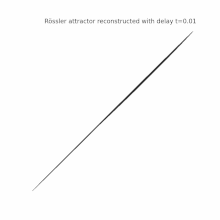This article includes a list of general references, but it lacks sufficient corresponding inline citations. (September 2020) |

In the study of dynamical systems, a delay embedding theorem gives the conditions under which a chaotic dynamical system can be reconstructed from a sequence of observations of the state of that system. The reconstruction preserves the properties of the dynamical system that do not change under smooth coordinate changes (i.e., diffeomorphisms), but it does not preserve the geometric shape of structures in phase space.
Takens' theorem is the 1981 delay embedding theorem of Floris Takens. It provides the conditions under which a smooth attractor can be reconstructed from the observations made with a generic function. Later results replaced the smooth attractor with a set of arbitrary box counting dimension and the class of generic functions with other classes of functions.
It is the most commonly used method for attractor reconstruction.[1]
Delay embedding theorems are simpler to state for discrete-time dynamical systems. The state space of the dynamical system is a ν-dimensional manifold M. The dynamics is given by a smooth map
Assume that the dynamics f has a strange attractor with box counting dimension dA. Using ideas from Whitney's embedding theorem, A can be embedded in k-dimensional Euclidean space with
That is, there is a diffeomorphism φ that maps A into such that the derivative of φ has full rank.
A delay embedding theorem uses an observation function to construct the embedding function. An observation function must be twice-differentiable and associate a real number to any point of the attractor A. It must also be typical, so its derivative is of full rank and has no special symmetries in its components. The delay embedding theorem states that the function
is an embedding of the strange attractor A in
- ^ Sauer, Timothy D. (2006-10-24). "Attractor reconstruction". Scholarpedia. 1 (10): 1727. Bibcode:2006SchpJ...1.1727S. doi:10.4249/scholarpedia.1727. ISSN 1941-6016.






